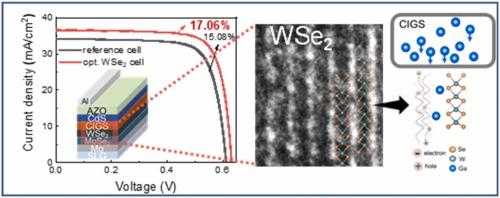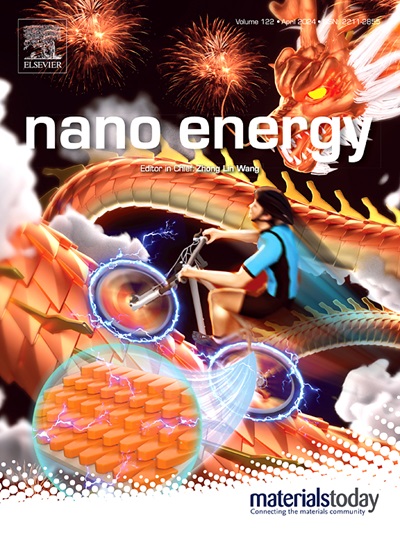Enhancing Cu(In, Ga)Se2 Solar Cell Efficiency with Vertically Channel-Stacked WSe2 Rear Passivation Layers
IF 16.8
1区 材料科学
Q1 CHEMISTRY, PHYSICAL
引用次数: 0
Abstract
The performance of Cu(In,Ga)Se2 (CIGS) solar cells was significantly improved by introducing a layered WSe2 thin film as a rear passivation layer in the back contact region. A vertically aligned stacking channel of the WSe2 thin film was obtained by converting a WOx thin film using a plasma-assisted selenization process. With the insertion of the WSe2 layer, we observed a notable accumulation of Ga at the rear side of the CIGS absorber layer, facilitated by the vertically channel-stacked WSe2 thin film. Increased open-circuit voltage is attributed to the reconstruction of the band alignment due to the modified Ga concentration profile, effectively mitigating electron flowing toward back contact and recombination within the back contact region of the CIGS solar cell. Furthermore, a favorable conductivity along the channels of the vertically channel-stacked WSe2 thin film and a steeper [Ga]/([Ga] + [In]) (GGI) gradient provide significant enhancements in short-circuit current density. The solar energy conversion efficiency of the CIGS solar cell, fabricated via a sequential process with elemental Se vapor, was boosted from 15.08% to 17.06%. The remarkable enhancement highlights the potential of employing two-dimensional materials as passivation layers in photovoltaic applications.

通过在背接触区引入层状 WSe2 薄膜作为后钝化层,Cu(In,Ga)Se2(CIGS)太阳能电池的性能得到了显著提高。通过等离子体辅助硒化工艺转换 WOx 薄膜,获得了垂直排列的 WSe2 薄膜堆叠通道。随着 WSe2 层的插入,我们观察到在垂直通道堆叠的 WSe2 薄膜的促进下,镓在 CIGS 吸收层的后侧显著聚集。开路电压的增加归因于修改后的镓浓度曲线重建了带排列,从而有效缓解了电子流向背接触和 CIGS 太阳能电池背接触区域内的重组。此外,垂直沟道堆叠的 WSe2 薄膜沟道具有良好的导电性,而且[Ga]/([Ga] + [In])(GGI)梯度更陡峭,从而显著提高了短路电流密度。通过使用元素硒蒸气的连续工艺制造的 CIGS 太阳能电池的太阳能转换效率从 15.08% 提高到 17.06%。这种显著的提高凸显了在光伏应用中使用二维材料作为钝化层的潜力。
本文章由计算机程序翻译,如有差异,请以英文原文为准。
求助全文
约1分钟内获得全文
求助全文
来源期刊

Nano Energy
CHEMISTRY, PHYSICAL-NANOSCIENCE & NANOTECHNOLOGY
CiteScore
30.30
自引率
7.40%
发文量
1207
审稿时长
23 days
期刊介绍:
Nano Energy is a multidisciplinary, rapid-publication forum of original peer-reviewed contributions on the science and engineering of nanomaterials and nanodevices used in all forms of energy harvesting, conversion, storage, utilization and policy. Through its mixture of articles, reviews, communications, research news, and information on key developments, Nano Energy provides a comprehensive coverage of this exciting and dynamic field which joins nanoscience and nanotechnology with energy science. The journal is relevant to all those who are interested in nanomaterials solutions to the energy problem.
Nano Energy publishes original experimental and theoretical research on all aspects of energy-related research which utilizes nanomaterials and nanotechnology. Manuscripts of four types are considered: review articles which inform readers of the latest research and advances in energy science; rapid communications which feature exciting research breakthroughs in the field; full-length articles which report comprehensive research developments; and news and opinions which comment on topical issues or express views on the developments in related fields.
 求助内容:
求助内容: 应助结果提醒方式:
应助结果提醒方式:


